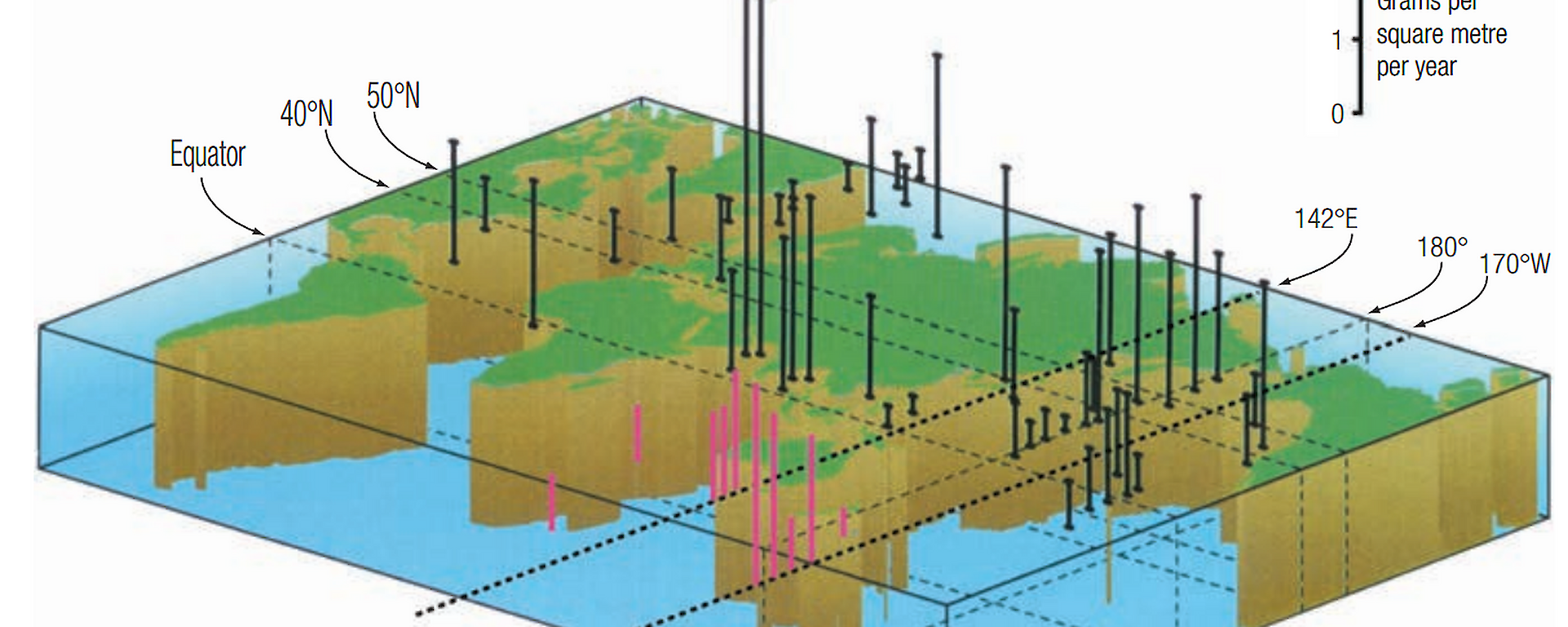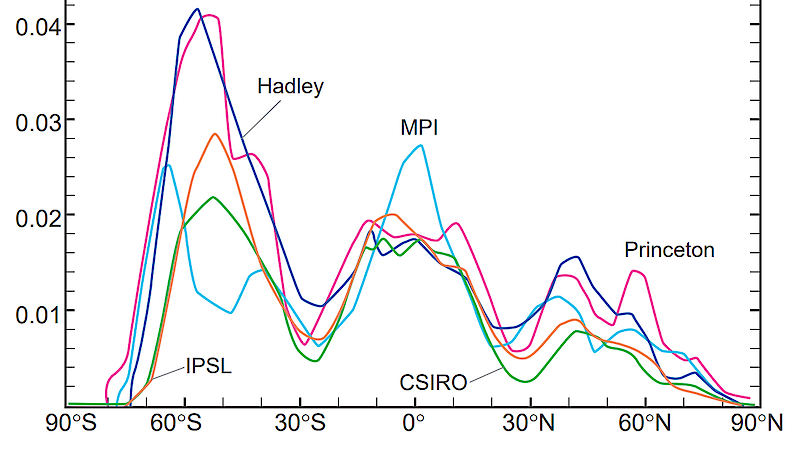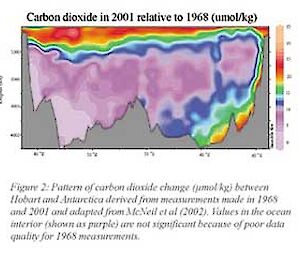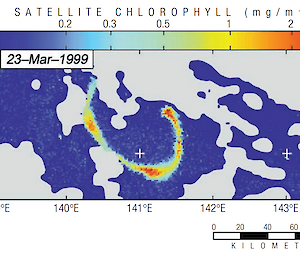Over the past ten years we have unravelled much of the major mystery that surrounded the role of the Southern Ocean in the global carbon cycle. We have made major advances in quantifying Southern Ocean uptake of anthropogenic carbon dioxide, and the role of Southern Ocean biological productivity in the transfer of carbon to the deep sea. But important puzzles remain.
Global carbon cycle models estimating the amount of anthropogenic carbon dioxide absorbed into the ocean from the atmosphere show a wider variation for the Southern Ocean than anywhere else. Even the observations are not in full agreement — atmospheric data suggests a smaller uptake than that estimated from ocean data. The effectiveness of biological processes in moving carbon from the surface to the deep sea is now recognised as high, but the reasons remain unclear, and thus the possible role of biological carbon transfers in past variations in atmospheric carbon dioxide levels remains unknown. Until these issues are resolved, we cannot predict the future of Southern Ocean contributions to the control of global atmospheric carbon dioxide levels.
The recent results from the Ocean Carbon Model Inter-comparison Project illustrate the range in model estimates of the oceanic uptake of anthropogenic carbon dioxide. Figure 1 shows the latitudinal flux of anthropogenic carbon dioxide into the ocean simulated by the models. The uptake peaks occur in the high latitude Southern Ocean, the equatorial ocean and the high latitude North Hemisphere. From the models, the global uptake of anthropogenic carbon dioxide for the 1980s varied between 1.5 and 2.2 gigatonnes of carbon (Gt C) annually which is about 30% of anthropogenic carbon dioxide emissions during this period. The Southern Ocean accounts for approximately 40% of the ocean uptake and 50% of the variability between the models. Observational analysis of the accumulation of anthropogenic carbon dioxide from repeat oceanographic measurements (Figure 2) suggests that the lower bound estimate of the uptake is more consistent with observations (Matear 2001).
Model-based predictions indicate the Southern Ocean is a major global sink for anthropogenic carbon dioxide, but sparse data and limitations in measuring techniques have made observational tests of the models difficult. High quality data now emerging from the internationally coordinated Joint Global Ocean Flux Study/World Ocean Circulation Experiment (JGOFS/WOCE) carbon dioxide ocean survey are providing information on how much and where anthropogenic carbon dioxide is accumulating in the ocean. These data are a vital test of the carbon dioxide uptake predictions from models and combined with atmospheric data are leading to a major improvement in our understanding of global and regional carbon budgets for both the oceans and land.
An example of the pattern of carbon dioxide accumulation along a hydrographic section in the Southern Ocean south of Australia is shown in Figure 2. The pattern of accumulation is intricately linked to the uptake shown in Figure 1 and to the large-scale circulation of the Southern Ocean. Old deep water that has a low anthropogenic carbon dioxide rises up in the offshore region around Antarctica and takes up carbon dioxide from the atmosphere. Some of this water mixes with other water before sinking to the seafloor, carrying with it anthropogenic carbon dioxide, to form Antarctic Bottom Water. The southern end of the section in Figure 2 is one of the few locations around Antarctica where surface waters become dense enough to sink to the seafloor and carry anthropogenic carbon dioxide.
A component of the water which originally welled up off Antarctica is carried north in the surface ocean. As the waters move north they exchange with the atmosphere taking up more anthropogenic carbon dioxide. Eventually, they contribute to the formation of Subantarctic Mode Water and Antarctic Intermediate Water. The mode and intermediate waters are subducted into the ocean interior taking anthropogenic carbon dioxide away from contact with the atmosphere. The formation and subduction of these water masses provide major pathways for anthropogenic carbon dioxide uptake by the ocean and help sustain the large uptake by the Southern Ocean.
Another major advance has been the recognition of the importance of iron to Southern Ocean ecosystems. Use of new measurement techniques and open ocean iron fertilisation experiments have shown that the lack of this essential micro-nutrient limits phytoplankton production in much of the Southern Ocean. Combining these observations with ice-core based estimates of increased dust supply during the time of the last major period of glaciation on Earth (the last glacial maximum, about 25,000 years ago), suggests that increased iron deposition from continentally derived dusts could partially explain the ~80ppm lower carbon dioxide levels of the glacial era in comparison to the pre-industrial era of a few hundred years ago.
Figure 3 shows a SeaWiFS ocean colour satellite image of a large ‘bangle’ shaped area, about 80km across, of abundant phytoplankton in the Antarctic Treaty region south of Tasmania (near 61°S). The enhanced growth, known as a ‘bloom', was artificially induced during the NZ-UK-Australian organized Southern Ocean Iron Release Experiment (SOIREE) by the addition of about 10 tons of ferrous sulfate heptahydrate over an area of around 55km2, and persisted for at least six weeks during which an eddy in the Antarctic Circumpolar Current stretched it out and curled it around into the bangle shape (Boyd et al., 2000).
Following SOIREE in 1999, additional iron fertilisation experiments have been carried out by US and European research consortiums, and more are planned. The primary goal of these studies is to advance understanding of the controls on phytoplankton communities and their role in the global carbon cycle, but they have also raised the possibility of intentional fertilisation for carbon dioxide management or even fisheries enhancement. Knowledge of marine ecosystems is still too rudimentary to permit the efficacy or risks of these ideas to be fully evaluated.
Iron limitation, cold waters, and low light levels (as a result of deep mixing driven by high winds) keep phytoplankton production at low to moderate levels in the Southern Ocean. But the amount of carbon transferred to the deep sea in settling particles appears to be surprisingly high — close to the global median, and higher than regions such as the North Atlantic where phytoplankton abundances are much higher. In Figure 4 the Southern Ocean results are shown in pink, and have all been obtained since 1997 by Australian, U.S., Japanese and French research groups.
The increase in Southern Ocean anthropogenic carbon dioxide contents has been determined from repeat observations along the WOCE SR3 section.
These carbon transfers to the deep sea are based on the particles collected in no more than a few square metres of sediment trap funnels, extrapolated to the millions of square kilometres which make up the Southern Ocean. Each trap has a large funnel and a set of about 20 cups which rotate beneath the funnel at fixed intervals during a year long deployment. The traps and the yellow floats that keep them upright after deployment are strung out in a line of equipment 3km long behind the ship before the final release of the 3 tonne mooring weight.
The ecosystem controls on these vertical particulate carbon transfers are not understood — we do not know which types of phytoplankton communities play the major role in this carbon ‘export’ from the top 100 metres of the sea, much less the role of the food-webs of the next 1000 metres in altering this ‘exported’ material. This includes the key issue of whether iron fertilisation leads to increased carbon transport to the deep sea, and not just increased surface phytoplankton production. No artificial iron fertilization has lasted long enough to assess export, and we are still developing methods (such as stable isotope compositions, biomarkers, and shell assemblages) to permit this possibility to be assessed from the deep ocean sedimentary records from the time of the last glacial maximum.
Planned future programs to further advance our knowledge of the Southern Ocean carbon cycle include:
- remeasurement of ocean carbon inventories to determine how climate variations affect atmosphere to ocean transfers,
- comparison of particulate carbon export between the iron-poor regions south of Tasmania and the relatively iron-rich regions near Heard, McDonald and Kerguelen Islands and
- development and deployment of automated moorings which can make biogeochemical measurements and collect biogeochemical samples to augment our growing but still very sparse observations from ships and satellites.
These programs are core objectives of the proposed Cooperative Research Centre for Antarctic Climate & Ecosystems, a proposal currently being evaluated for possible funding. If approved, this will take the place of the existing Antarctic CRC, due to wind up in June 2003.
Tom Trull,
Antarctic Cooperative Research Centre,
and Richard Matear & Bronte Tilbrook,
Antarctic Cooperative Research Centre & CSIRO Marine Research
References
Matear, R. J. (2001). “Effects of Eddy Para metreizations and Numerical Advection Schemes on Ocean Ventilation and Anthropogenic carbon dioxide uptake of an ocean general circulation model.” Ocean Modelling 3: 217-248
McNeil, B. I., B. Tilbrook and R. J. Matear (2001) The storage and uptake of anthropogenic carbon dioxide in the Southern Ocean south of Australia between 1968 and 1996. Journal Geophysical Research, 106: 31,431
Orr, J. C., E. Maier-Reimer, U. Mikolajewicz, P. Monfray, J. L. Sarmiento, J. R. Toggweiler, N. K. Taylor, J. Palmer, N. Gruber, C. Sambine, C. Le Quéré, R. M. Key and J. Boutine (2001). “Estimate of anthropogenic carbon uptake from four three-dimensional global models.” Global Biogeochemical Cycles 15: 43-60.





